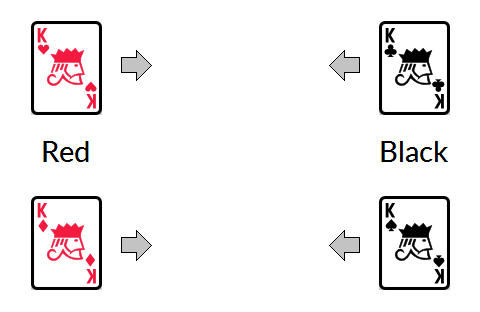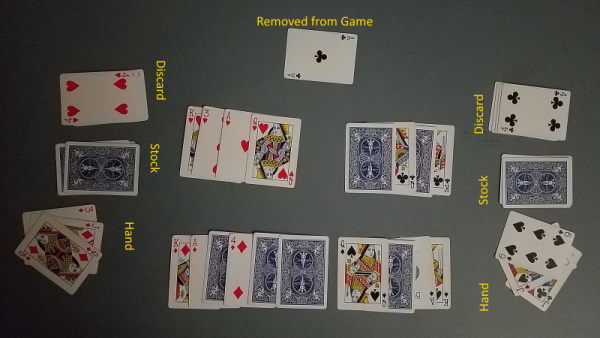
A card game for 2 players, © by Bill de Veas, 2020-01-28
Build your “towers” and prevent your opponent from building theirs.
The goal is to have 5 cards on one of your “towers” by the end of your turn.
Separate a standard French-suited card deck into red and black suits, without [8, 9, 10, Joker] cards. One player takes the red stock, the other the black stock.
Each player lays their two [K] cards on the table, to form a rectangular play area between the four cards.
The [K]s represent tower bases, and identify each tower's suit. Each tower shall face an opponent's tower. (See example below.)

Then, players shuffle their stock decks, deal themselves 3 cards, and determine who goes first.
The general idea is to play cards on one of your towers (of the same suit as the tower, in any order) in the form of a column of partially overlapping cards in the direction of the opponent's tower that faces it.
In the example above, hearts and clubs target and build toward each other; diamonds and spades target and build toward each other.
The value of the top card on the tower (not including the base card) indicates the tower's current defense/attack power. Special cards have a variety of other effects.
The goal is to be the first player to get one of their towers to an unassailable height of 5 (that is, 5 cards on top of the [K] base).
Players take turns either:
When one's stock has been emptied, turn over the discard pile and shuffle it for use as the new stock.
The numeric cards and [J] are army cards. The [Q] and [A] are effect cards.
Always play effect cards face-up.
All other cards are to be played face-up if the top cards on both the tower to be played on and its opposing tower are already face down – otherwise, play either face-down or face-up at the player's discretion.
When (and only when) an army card is played on a tower that faces a tower that also has an attackable card on its base, either player may declare a battle between the top cards on those towers.
When a battle is declared, any face-down card on top of either participating tower is flipped face-up, to compare values. The higher card stays on its tower, remaining face-up; the other one is removed. In event of a tie, remove both sides' cards. [A]ces are low (value 1). An exposed [J] causes the loss of all cards on its tower.
[A], [Q], and [J] are special cards which have special rules:
A player wins the game by having 5 cards on their tower base (a column of 6 cards) at the end of their turn.
The simplest way to score is to just award 1 point per win.
At the start of each game, right before the players shuffle their stock decks, each player selects one numeric card (2-7) of either suit from their stock, and places it face-down between their two towers. The value of this card becomes the player's score if they win.
(If a player wins but their scoring card is an [A], [Q], or [J], then they forfeit and the losing player scores instead.)
Between games, each player may return their card to their stock and choose a different numeric card.
Play until one player's total score reaches or exceeds an agreed-upon amount.
TNT: Add the 10s to each player's stock. 10s cannot be played on towers; they can only be discarded. If a 10 is discovered to have been played on a tower, the player who owns the tower immediately loses the game.
In the photo below, Red has won, with a completed tower on Diamonds.
